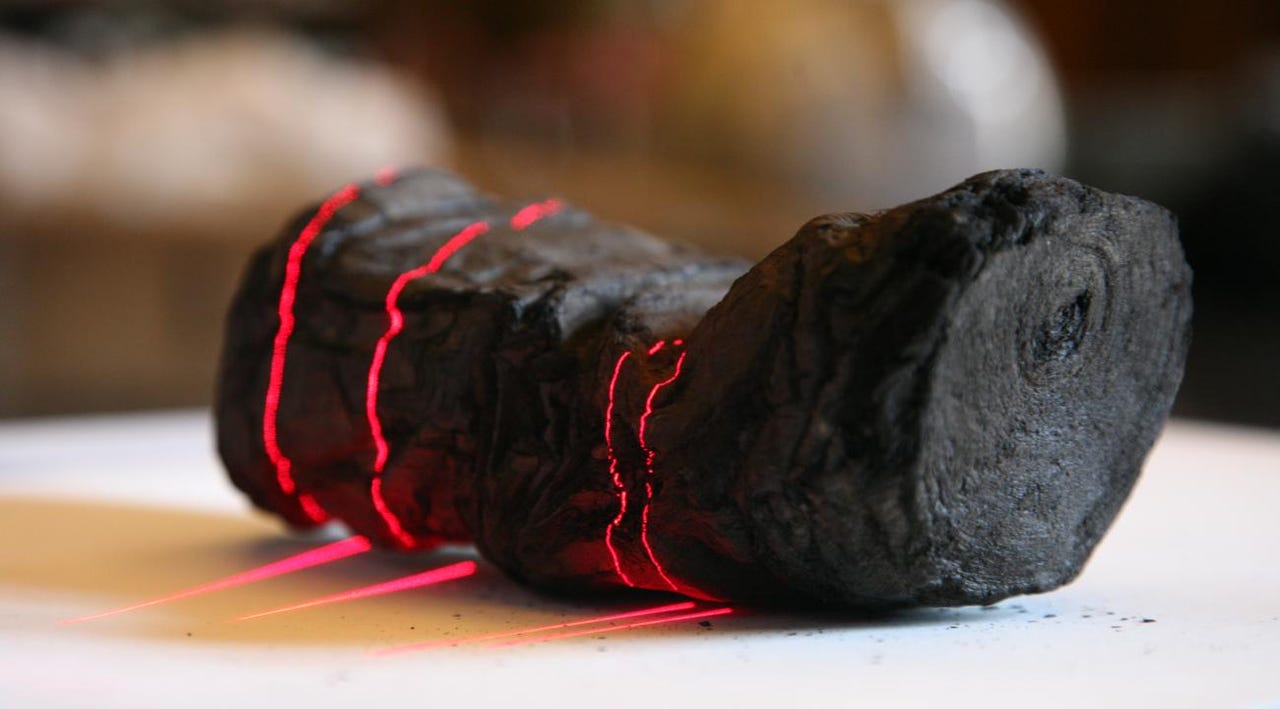
































Herculaneum scroll with red laser lines being scanned at Institut de France by Brent Seales and his team.
After a historic volcanic eruption, two millennia, and an international effort to use artificial intelligence to read a set of mysterious ancient scrolls, researchers know what at least one Roman Epicurean philosopher had on his mind: food.
Humans, while full of surprises, can be endearingly predictable.
The revelation comes as the culmination of the Vesuvius Challenge -- a contest launched in March 2023 by University of Kentucky researcher Brent Seales, former GitHub CEO Nat Friedman, and entrepreneur and investor Daniel Gross. The goal was to take computed tomography (CT) scans of what are known as the Herculaneum scrolls as well as machine-learning-based software and put these in the hands of tech-savvy sleuths from around the world in hopes someone could read the scrolls without even touching them.
Also: This is what AI will produce during the next decade and beyond
With support from Silicon Valley, organizers dangled prize money for progress in the pursuit of reading the writing once buried and carbonized in the eruption of Mount Vesuvius. That included$700,000 which will be split among the winning team of three: Youssef Nader, Luke Farritor, and Julian Schilliger -- all students. They submitted 15 columns of text, which preliminary analysis suggests contains writing about whether the scarcity or abundance of goods like food affects how pleasurable humans find them.
The Vesuvius Challenge marks a pivotal moment in the quest to get inside the scrolls. It's also a big moment for Seales, the researcher from the University of Kentucky -- he's been trying to accomplish this for the last two decades.
Seales and various incarnations of his team have never been closer to reading the trove of texts. In a way, the contest's December 31 deadline didn't really matter. The challenge, both in terms of the grand prize and the puzzle itself, goosed interest and recruited new collaborators whose contributions Seales compared to about 10 years of human work in just the first three months.
"It's astounding to feel this kind of redemptive power that we may hold now because of AI and tomography and computation," Seales said in an interview before the grand prize announcement.
It might seem like a lot to go through but Michael McOsker, a researcher who has studied the scrolls, estimates all these efforts could yield what amounts to about 200 new books. The collection is also the only surviving library from antiquity.
"We have probably less than 1% of ... all the literature that was written," he said. "Any gain in our knowledge is important."
Brent Seales and Seth Parker (Digital Restoration Initiative project lead) scanning a replica of the Herculaneum scroll on the University of Kentucky campus.
Seales didn't set out to spend two decades unwrapping ancient texts. Originally from Western New York, he was an imaging specialist with an interest in AI. The problem: there wasn't much happening with AI back then. Computer vision, however, seemed like one area where progress was being made.
He met a professor at the University of Kentucky in the mid-1990s who was working on a manuscript of the Anglo-Saxon epic poem Beowulf at a time when there was a push to digitize libraries. Having read Beowulf in high school, like so many kids, Seales' interest was piqued. He thought about the power of digitizing this one text -- the one extant manuscript to witness the story.
Also: A year of AI breakthroughs that left no human thing unchanged
Digitization transitioned into restoration. Once a text was digital, the image quality could be improved. Just making a copy didn't have to be the end. And if they could digitally flatten a wrinkled document, why couldn't they also unfurl it?
"We invented the idea of completely unwrapping something before we knew about the things that we were going to actually unwrap," Seales said.
In 2004, Seales finally found something to unwrap when a University of Michigan classics scholar named Richard Janko told him he'd identified the perfect fit.
Enter: The Herculaneum scrolls.
The Greek characters,
 Etiquetas calientes:
innovación
Etiquetas calientes:
innovación